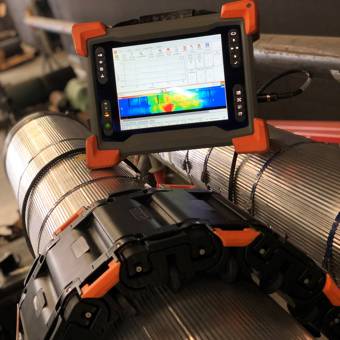- Pulsed Eddy Current Testing - PECT is a rapid screening corrosion assessment (remaining % thickness measurement) method utilized primarily on insulated ferrous pipelines, tanks & vessels eliminating the operating asset’s downtime.
- Corrosion survey without removing up to 150mm thick insulation on the test surface having temperature up to 550 degree Celsius (hot or cold)
- Measure wall thickness through any non-conductive insulation materials such as natural fibers, asbestos, fireproofing, coatings, ceramic, concrete, brick, foam, wool, thermocol, bitumen, etc
- Measure thickness through galvanised, stainless, aluminium, cladding or weather jacket
- Measure thickness through chicken or hog wire reinforced insulation, straps or protective and polymer coating
- No need for surface preparation (scan over corrosion scab or blister) thus minimized risk and cost saving for the plant owner by avoiding grinding or removal.
- Measure thickness from 4 to 65mm on pipes above 75mm diameter or vessels or spheres or support legs.
- No need for scaffolding. Remote control inspection using extension arms up to 4.6m height.
- Battery powered instrument. Perfect for remote locations.






- Corrosion under insulation CUI is one of the most undetectable corrosion mechanisms that can affect the integrity of the plant or asset and may not be noticed until the degradation has occurred beyond risk mitigation. Corrosion under insulation CUI, as the name suggests occurs under the insulation layer which is not readily visible to the plant operators. Pulsed Eddy Current - PEC testing can provide wall thickness measurements through any non-ferrous insulation materials such as natural fibers insulations material, calcium silicate, titanium based coatings, ceramic paint, concrete, brick, foam, wool, thermocol, bitumen, dirt, sludge, etc. It can also measure through galvanised, aluminum and stainless weather sheeting.
Ideal Applications:
- Detection of corrosion under insulation CUI degradation
- Detection of internal flow induced erosion or corrosion
- Wall thickness measurement of tanks or pipe-rack without additional cost of scaffolding work or use of elevated working platforms
- Wall thickness measurement of excavated pipelines without coating removal and without sand blasting or surface grinding.
- Most ideal on insulated, cladded, covered material surface. Subsea and splash zone inspection
- Pulsed Eddy Current - PEC testing on high temperature surface without shutting down plant
- Inaccessible test surface e.g. covered with asbestos or brick wall or sand covered
- Hot or cold insulated pipelines, vessels, equipment, columns, storage tanks, concrete coated sphere legs
- Insulated pipes above 100mm diameter or vessels or spheres
- Pulsed Eddy Current - PEC testing can measure wall thickness from 4 to 65mm with repeatable results within the range of ±10%.










Advantages:
- Absolutely safe. X-Ray or Gamma Ray radiation NOT involved.
- No need to remove insulation, cladding, asbestos, fireproofing, concrete, coating from test materials
- Pulsed Eddy Current - PEC testing can be performed on insulated materials thus eliminating the operating asset’s downtime
- Cost saving for the asset owner by not removing or reinstating insulation
- Pulsed Eddy Current - PEC testing can be performed on insulated materials having test surface temperature up to 550 degrees Celcius.
- Measurement accuracy of ±10% of measured wall thickness
- Pulsed Eddy Current - PEC testing can be performed on insulated layers up to 150mm thick
- Test over corrosion scabs or blisters. No need of surface preparation thus cost saving for the plant owner.
- Pulsed Eddy Current - PEC testing instrument is battery powered and hence perfect for remote locations.
- PEC probes are water proof and hence they can be efficiently applied in marine environment.
- PEC probes can be connected to 30m long telescopic extention arms for measuring under water. Perfect for piers at ports and bridges.
Limitations:
- Thickness readings are average thickness under the sensor footprint measured in % remaining wall.
- PECT measures average thickness at the test location (probe footprint) which varies between 35-200mm depending on insulation thickness, clad material and the wall thickness of the test material. Thickness readings are average thickness under the sensor footprint (1.8 times the footprint) measured in % remaining wall.
- Pulsed Eddy Current - PEC testing cannot detect a small isolated pit
- The edge effect impacts PEC measurements when a probe nears geometry variations such as nozzles, flanges, or the end of a structure. Measurements begin to vary from a distance of one Footprint from the center of a probe’s coils.
- Difficult to use on elebows smaller than 200mm diameter
- Current version of software is unable to discriminate near side and far side defects.
- Flaws smaller than the averaging area of the probe will be undersized.






